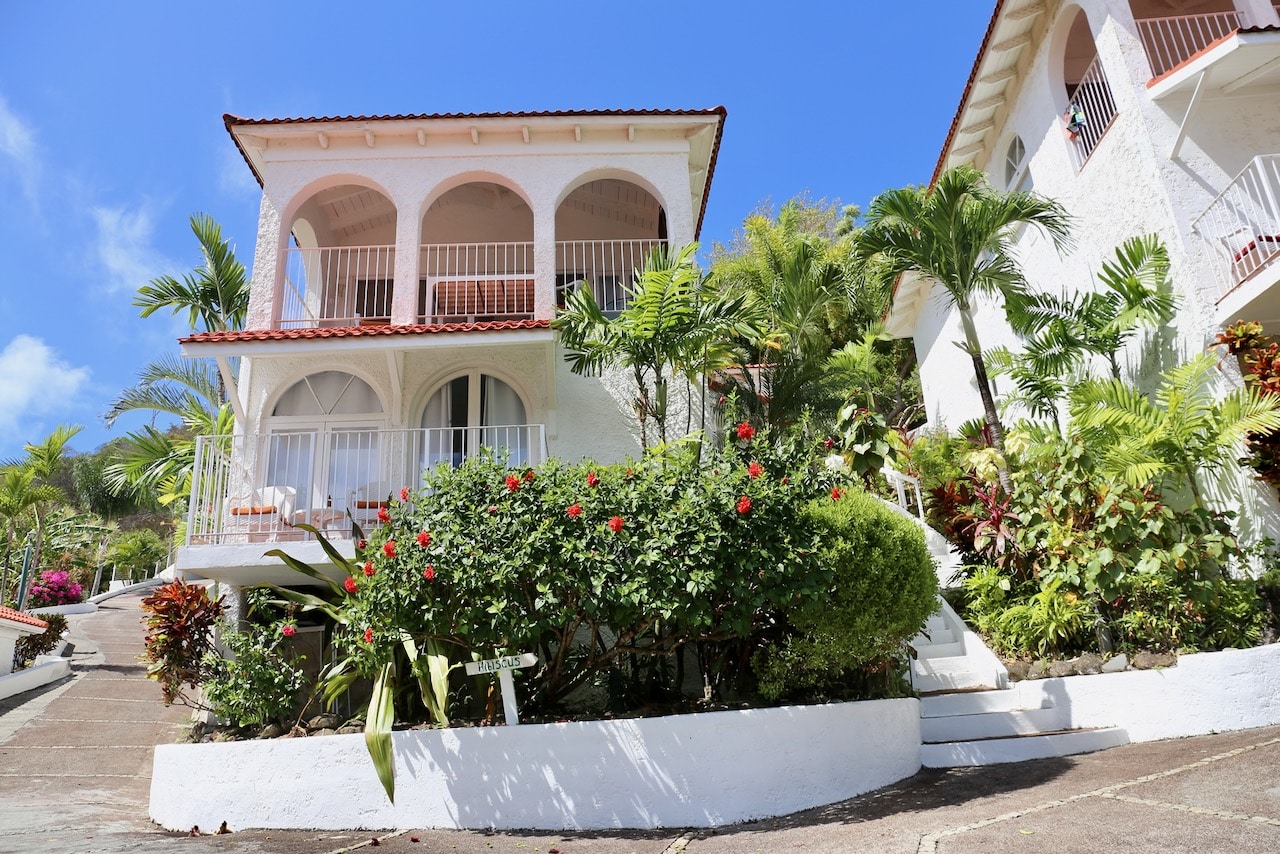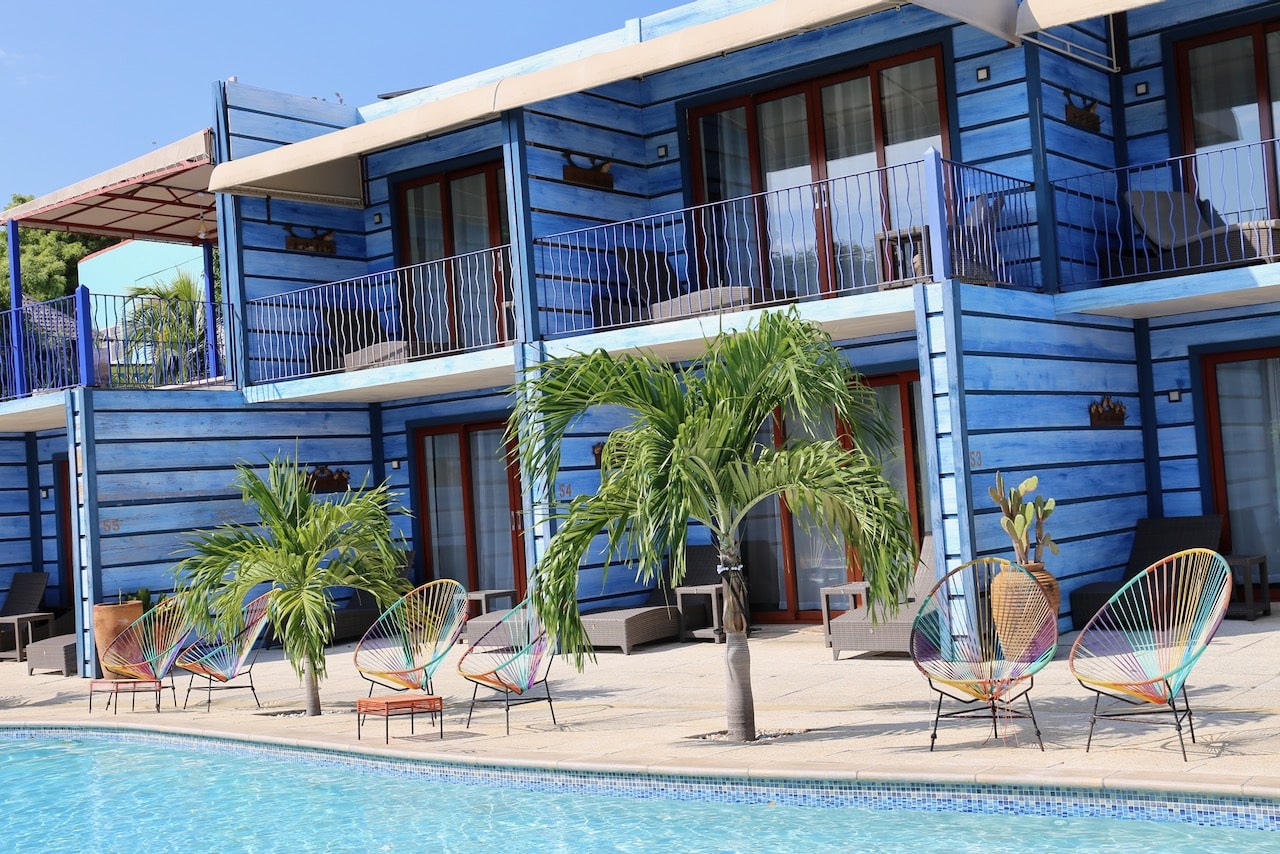I rushed off my plane and ran into the Siem Reap Airport. There were about 200 people on my flight who all had to fill out Cambodian Tourist Visa forms and and I wasn’t about to wait around for hours in line. After paying the $25 USD fee I grabbed my bags at the carousel and walked to the entrance where hundreds of taxi drivers held up signs to pick up passengers. I found my name in dark blue marker, “Adre Dopson.” The man gave me a big smile behind his aviators and large black motorcycle helmet. We shook hands and he carried my bags to the parking lot.
I soon found myself sitting on the back of a local taxi called a Tuk Tuk. The driver sits on a motorcycle which is attached to a two wheeled wagon which follows behind. I sat up on my seat and was quickly introduced to Siem Reap’s infamous dusty roads. I had to cover my hands over my face in order to prevent the dust from entering my nose, eyes and mouth. The streets are full of young girls who are paid to sweep the sidewalks, creating large pyramidal towers of sand which they then scoop up and wheel off the streets in little wagons.
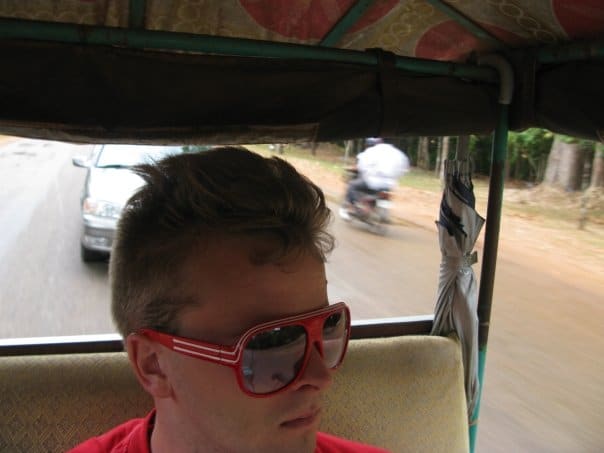
I arrived at Rosy Guesthouse half awake and covered in a thin film of dust. This newly renovated guesthouse instantly set me at ease as I was in dire need of a clean, safe and comfortable place to spend the next few days. I was ushered into my private room (7 USD a night) which featured a powerful overhead fan, TV and DVD player, and coffee maker. The room was spotless, the bed was comfy and the ceiling was decorated with classic Victorian cornicing. I sighed, ran into the shower and then crashed into my bed for a much needed nap at 9am.
An hour later I woke up and decided to hit the streets. I first walked through the Royal Gardens and Prasat Preah Ang Charm Temple. Passing through the lotus gardens I walked back towards the river which runs right through the city towards the downtown hub where all the nightlife action is. I arrived at the town centre and was pleased to see hundreds of cafe’s, lounges and bars. People from all over the world fly to Siem Reap as it is the gateway to the world famous Angkor Wat. The city has a very multi-cultural vibe. I listen intently wherever I am, trying to guess what country people are from. I’ve become very good at pin pointing Swedish couples, German families and Korean and Japanese tourists.
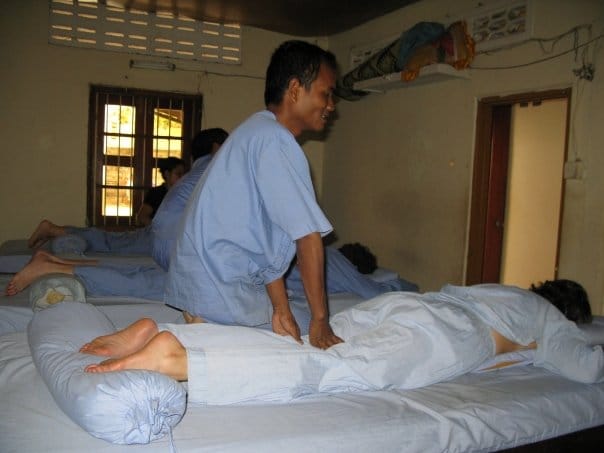
I continued to stroll through town until I found Seeing Hands Massage, a clinic run by the blind. I hopped on a bed and readied myself for shiatsu. I have had plenty of massages in my day but this was my first traditional shiatsu. I don’t really enjoy people poking me until I bruise so I had to tell my attendant to soften it up a bit. There were three big fat German women who were being massaged beside me. I noticed that a blind masseuse is different from all others as they use their hands to see (hence the “seeing hands massage,” slogan). I found myself being tapped, and rubbed from shoulder to shoulder so that my attendant could figure out where my body was on the table. He would then lightly touch various bones and muscles before putting pressure on the different parts of my body. A British woman beside me looked up at me and laughed. I couldn’t help but laugh with her as we both had two little Cambodian men straddled on top of us. I listened very carefully as the blind men pounding our backs shared a rather lively (and what appeared to be humorous) conversation. Cambodian is a very odd language, full of clucking and the use of the back of your throat to make long ribbit frog like noises.
After my massage I walked across a busy intersection and noticed a man on the street selling gasoline to motorists. I looked around to discover that all motorcyclists fill up their tanks this way. There are hundreds of gasoline stands on the streets in Cambodia. You just have to keep your eyes open for them. Gasoline is sold in Johnny Walker glass whisky bottles. I kid you not. The yellow fluid is emptied from the glass bottle and costs approximately 60 cents. I had a good laugh once I realized that this was Cambodia’s third world solution to the more pricey concept of a gas station.

That evening the air had a faint pink tinge to it as I skipped along the river past several love struck local couples who fondled each other on park benches. I ate my first Khmer meal (traditional Cambodian cuisine) at the city’s famous Angkor Kitchen. I ordered a delicious bowl of pumpkin, coconut and chicken curry which I poured over a plate of steaming rice. I quenched my thirst with a large bottle of the locally brewed Angkor Beer.
I woke up early in the morning and after stepping out onto the street was barked at by several eager Tuk Tuk drivers. I bartered with the man who picked me up at the airport and we agreed that he would drive me around the Angkor Temples for the day for 10 USD. We shook hands and he introduced himself as, Limnil.
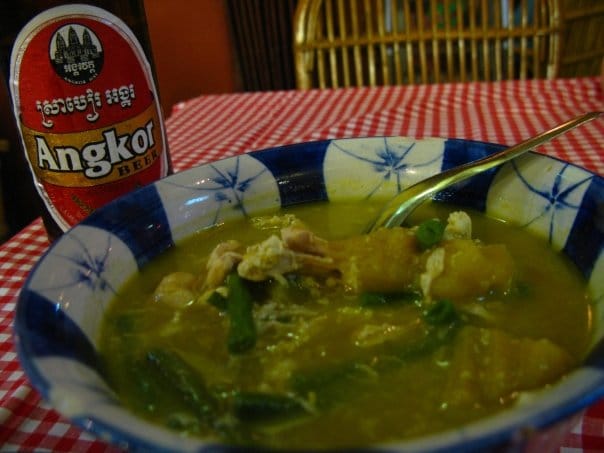
I hopped onto the back bench of his Tuk Tuk and screamed in a thick British accent, “My good man Limnil, let us go, to the Temples of Angkor!” The main road which leads to the Angkor Archaeological Park is crammed full of traffic in the early morning as thousands of tourists flock to the temples for a day of sightseeing. The street was lined with policemen who blew on their whistles and created a rather bustling atmosphere. The combination of exhaust, dust, screaming, honking and whistle blowing is a sure way to wake yourself up in the morning. Ten minutes up the road we stopped at the ticket office where I bought a three day pass for the temples for 40 USD. We then drove back onto the main road and soon found ourselves outside of the city and surrounded by thick forest. We reached a T-Intersection in the road and turned left. All of a sudden we were driving along what appeared to be a river (but in reality was a huge moat which surrounds Angkor Wat). The first bit of road was under construction and therefore outrageously bumpy. The Tuk Tuk bounded in the air as we banged ourselves over pot holes of clay and dust. I thought to myself, “I may lose my lunch, and I haven’t even eaten lunch yet!”

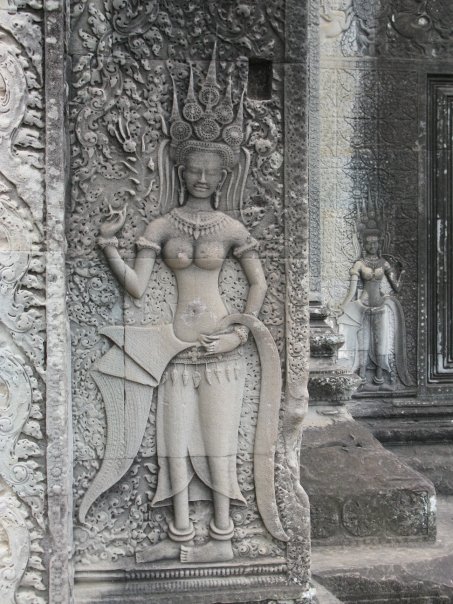
The Temples of Angkor, capital of Cambodia’s ancient Khmer empire, are the perfect fusion of creative ambition and spiritual devotion. Between the 9th and 13th centuries the Cambodian devaraja strove to better the temples of their ancestors in size, scale and symmetry, culminating in the world’s largest religious building, Angkor Wat. The hundreds of temples which survive today are the sacred skeleton of a vast political, religious and social centre of an empire that stretched from Burma to Vietnam, a city that boasted a population of one million when London was a little town of 50,000 inhabitants. The houses, public buildings and palaces were constructed of wood — now long decayed — because the right to dwell in structures of stone was reserved for the gods.
The ‘lost city’ of Angkor became the centre of intense European popular scholarly interest after the publication in the 1860s of Le Tour du Monde, an account by the French naturalist Henri Mouhot of his voyages. A group of talented and dedicated archaeologists soon undertook a comprehensive program of research. They made an arduous effort to clear away the jungle vegetation that was breaking apart the monuments, and to rebuild the damaged structures, restoring them to something approaching their original grandeur.
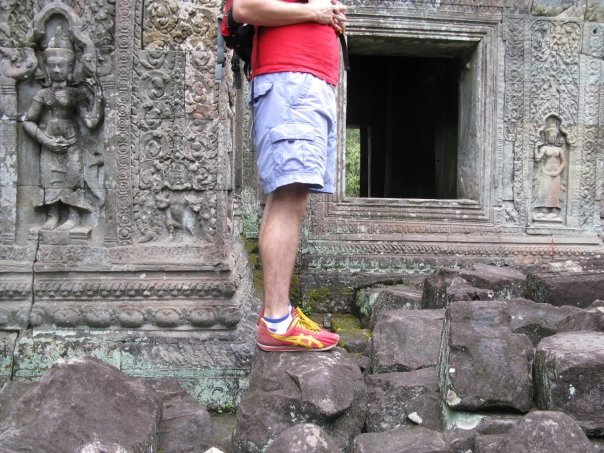
There are two main Angkor Courses. The Grand Tour and the Classic Tour. I chose to do the Grand Tour on my first day as it covered the less touristy temples in chronological order (so you can see how the ancient Khmer civilization gradually became more advanced architecturally). The Grand Tour features the following Temples which can be seen comfortably in six hours: Preah Khan, Preah Neak Pean, Ta Som and East Mebon.
Fortunately I was in Cambodia during the best season of the year. I had heard so many horror stories of people who complained about sweating the entire day at the Temples. Returning to their hotels dehydrated, drained and burnt from the sun. As we drove towards the first temple of the day the morning air was actually cool.
My first temple, Preah Khan once housed more than 1000 teachers an may have been a Buddhist University. It’s one of Angkor’s largest complexes, a maze of vaulted corridors, fine carvings and lichen-clad stonework. The temple is shaped in a cruciform. It’s southern corridor is a wonderfully atmospheric jumble of vines and stones, while near the eastern entrance there is a curious two-storey structure that would look more at home in Greece than in Cambodia. Preah Khan is a genuine fusion temple, the eastern entrance dedicated to Mahayana Buddhism, with equal sized doors, and the other cardinal directions dedicated to Shiva, Vishnu and Brahma, with successively smaller doors, emphasizing the unequal nature of Hinduism.
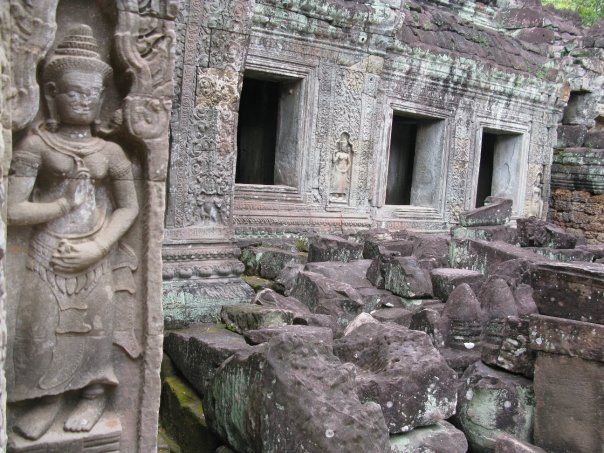
The next temple, Preah Neak Pean is like the ultimate ornamental pond at some Balinese resort. It comprises a central tower set in a square pool and four smaller ponds laid out symmetrically around the center, each with an interesting subterranean carved fountain. The temple was originally set in a massive reservoir called Jayataka that fed Preah Khan.
Ta Som is a tiny little temple which would be easy to overlook, but the eastern gate here has been absolutely overwhelmed by an ancient tree that has sent its intrusive roots on a destructive mission into every nook and cranny. My fondest memory of this temple was when I walked along a path towards the temple and was stopped by a group of boisterous toddlers. Two small girls held their hands up to me and screamed, “You buy postcard. One for yourself and one for your girlfriend!” I was soon amazed as they went on a mile-a-minute ramble. Each postcard deck came with ten cards. So the girls, in order to impress you into buying the cards, quickly counted from 1 to 10 in about twenty different languages. First in English, then German, French, Italian, Chinese, Japanese…you name it, they spoke it!
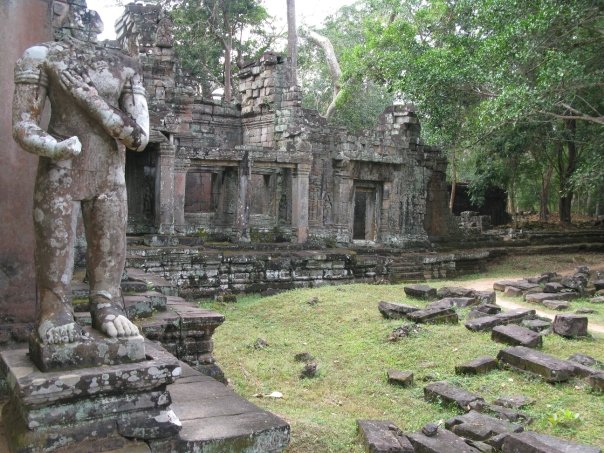
I waved down my good man Limnil and we were once again bolting across the open Angkor paths to East Mebon Temple site. I decided to stop here for lunch (its fun to even say “I decided to stop here” as it was my first time in life having my own personal chauffer who had to take me wherever I wanted). As soon as I walked up to the restaurant stalls five or six ladies bolted out of their chairs, grabbed their menus and ran at me screaming. I actually stopped and took a quick picture as they were being entirely outrageous. I had never seen anything like it. Each restaurant sold pretty much the same thing. Each lady would say “same same but different,” when I asked why their menu was better than the next one. Ladies from each of the restaurants would actually grab my arm and pull me into their restaurants. If I spent a minute or two talking to one of them about their menu and then turned away they would automatically drop their price for the dish or respond, “How much you pay?” I ended up relaxing with a Asahi Beer while munching on a bowl of chicken curry at a table with a few guys from Venice.
East Mebon was my final stop of the day. I was borderline exhausted from the sun and was also worrying about the fact that I had just eaten a bowl of curry from a little roadside stand. The last thing I wanted was a rumble in my jungle after climbing 200 steps. East Mebon had a very different architectural style compared to the other temples of the day. The stone was made of porous rock that looked volcanic. I had to climb about a million steps from one level of the main temple structure to the next. Some of the steps were so steep I could barely look down in fright that I’d plummet to my death. The steps themselves were also incredibly tiny I could barely fit my toes on them let alone my whole foot. Once at the top I took a deep breath, leaned against a lion statute and stared 360 degrees around the beautiful temple rooftops which surrounded me. After a long day of Temple’ing I was ready to get back to my hotel, shower and take a nap before I headed out for a night on the town. Trouble was, I had to walk down the way I had climbed up! Good grief! Lamnil, Help!
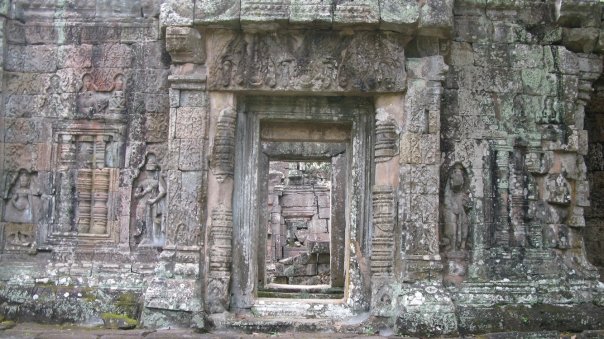
On my final day at the Angkor Archaeological Park I would be strolling with the tourist hoards to the most famous sights. Soaring skywards and surrounded by a moat which would make its European castle counterparts blush, Angkor Wat is one of the most inspired and spectacular monuments ever conceived by the human mind. Some researchers believe a walk from its outer causeway to its inner confines is a symbolic trip back to the first age of the universe’s creation. Others point out it also replicates the spatial universe in miniature; the Hindu’s mythical Mt Meru represented by the massive central tower, with its surrounding smaller peaks (lesser towers) surrounded in turn by continents (lower courtyards) and oceans (moat). The seven headed naga (mythical serpent beings) along the causeway become a symbolic rainbow bridge for man to reach the abode of the gods. Angkor Wat, the largest religious building in the world, really does hit you with an initial, “wow.”
It was built by SuryavarmanII to honor Vishnu, his patron deity, and to be his funerary temple. The central temple consists of three elaborate levels, each of which encloses a square surrounded by intricately interlinked galleries. Rising 31m above the 3rd level and 55m above the ground is the central tower, which gives the whole ensemble its sublime unity. Surrounding the central temple complex is an 800m-long series of extraordinary exquisite bas-reliefs. The most celebrated scene, the Churning of the Ocean Milk, is located along the southern section of the east gallery. This brilliantly executed carving depicts 88 asura (demons) on the left and 92 deva (gods) with crested helmets on the right, churning up the sea to extract the elixir of immortality.

I most enjoyed walking around the grass filled fields which surround the main gate. Directly in front of the main gate is a large lily pond where the temples reflect into the deep blue water. Locals offer donkey rides around the temple grounds and hot air balloons can be seen floating in the distance as tourists stare out over the Angkor complex several hundred feet above the ground. One really gets a multicultural experience at Angkor Wat. Tourists from all over the world hire Cambodian tour guides who speak a plethora of languages (French, German, English, French, Korean, Japanese, Chinese and Russian). It is sort of funny to watch a small Cambodian woman describing the temple details in French to a pair of gorgeous newlyweds from Paris. I also noticed several photographers directing local couples dressed in their wedding bests. It seems as though the classic Cambodian wedding shots are taken against the countries most famous ruins.
After walking through the massive temple I walked on the outskirts where I found a small monk village. I walked into a temple where I bowed and smiled at several bald men wrapped in bright orange. Walking around the temple I stared up at several large frescos and was most entertained by the mural which depicted the pains experienced in hell. Horrifying scenes of people being bludgeoned by men with chicken heads, speared in the ass, tongues ripped out, eaten by birds and wolves and even sawed through the skull.
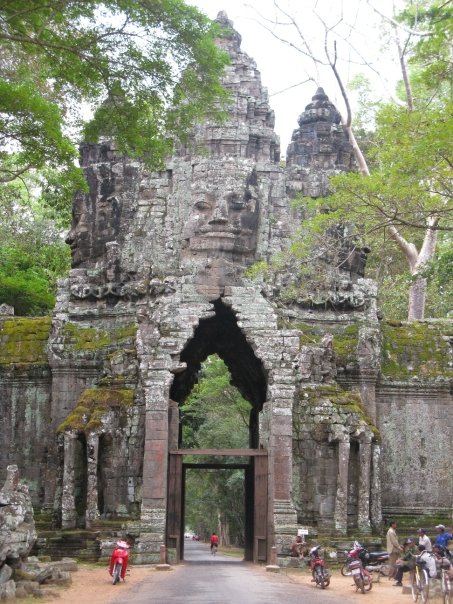
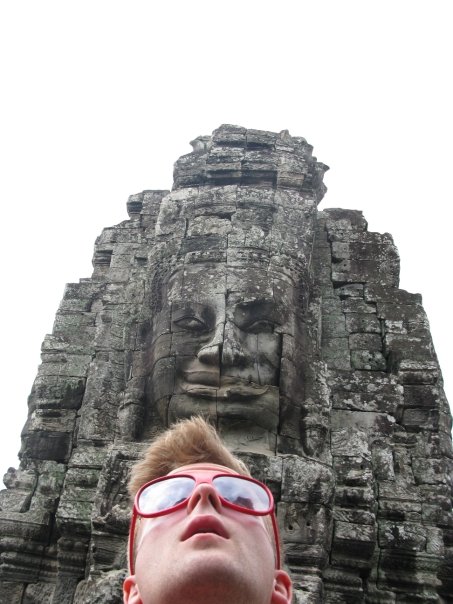
Lamnil found me as soon as I stepped back into the parking lot. We rushed through the forest and drove into massive Angkor Thom. This fortified city of Angkor has five monumental gate entrances: East, South, West, North and Victory Gate — each topped by four serene faces of Avolokiteshvara (the Buddha of compassion). The city’s walls stretch more than 12km, and are 6m high and 8m wide every step of the way. Angkor Thom was built by Angkor’s greatest king, Jayavarman VII (1181-1211), who came to power after the disastrous sacking of the previous Khmer capital by the Chams.
The most impressive of the fortified cities monuments is Bayon. Built in the latter part of the 12th century by King Jayavarman VII, Bayon is one of the most widely recognized temples in Siem Reap because of the giant stone faces that adorn the towers of Bayon. There are 54 towers of four faces each, totaling 216 faces. There is still a debate as to who is being depicted in the faces. It could be Avalokiteshvara, Mahayana Buddhism’s compassionate Bodhisattva, or perhaps a combination of King Jayavarman VII and Buddha.
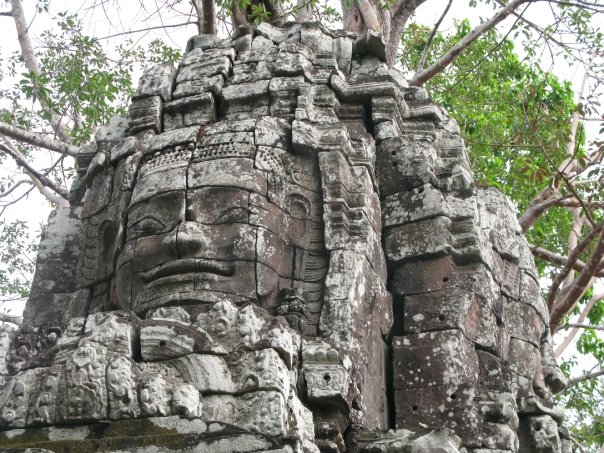
Bayon’s plan can be divided into three levels — the first two are bas-reliefs and the uppermost consists of the central sanctuary. The outer gallery depicts scenes from everyday life and historical events, while the second inner gallery depicts mythical figures and stories. In total, there are more than 1km of bas-reliefs to be viewed in the Bayon, incorporating a staggering 11,000 figures. The most elaborate carvings on the outer wall of the 1st level depict vivid scenes of life in 12th century Cambodia, including cockfighting and kickboxing.
Located to the northwest of the Bayon, the Baphuon is supposed to represent Mount Meru (sacred to Hinduism), and was one of the largest and grandest structures in Angkor. Built into the western face of the Baphuon is a giant reclining Buddha, added in the 15th century after the region converted from Hinduism to Buddhism. Archaeologists had dismantled the Baphuon to perform renovation when they were interrupted by the civil war; the records for piecing the temple back together were subsequently lost or destroyed. Today it is undergoing painstaking reconstruction work, so visitors can only walk across the long terrace leading up to the main structure and around the outside base.
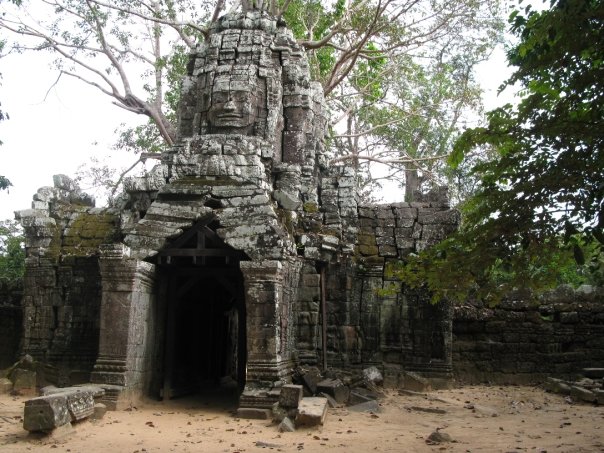
The Terrace of Elephants boasts stairways with three headed elephants and retaining walls laden with gargantuan bas-reliefs of elephants along this monumental terrace’s central stairway, which is held aloft by the outstretched arms of garuda (mythical half-man, half-bird creatures) and lion-headed figures. The 300m long terrace was originally topped with wooden pavilions decorated with golden framed windows. It was used as a giant reviewing stand for public ceremonies and parades, and served as the king’s grand audience hall.’
The Terrace of the Leper King, just north of the Terrace of the Elephants, is a carved 6m high platform on top of which stands a mysterious statue. Researchers now believe it is Yama, the god of death, and that this site served as a royal crematorium. The front retaining walls are decorated with seven tiers of meticulously executed carvings, including numerous seated apsara (dancing girl or celestial nymph). More spectacular still are the evil looking figures found in the hidden trench behind the front retaining wall. They look as if they’d been carved yesterday, as they were covered over when the original terrace was enlarged centuries ago.

My final sight of the day was Ta Prohm. One of the most spectacular of Angkor’s many wonders, Ta Prohm looks like it fell straight out of a film set from Indian Jones; in fact, Ta Prohm was used as a set for shooting both Tomb Raider and Two Brothers. This 12th century Mahayana Buddhist temple is one of the Angkorian era’s largest edifices and has been left much as it looked when the first French explorers set eyes on it more than a century ago. Inside, the temple is a maze of narrow corridors and crumbling stonework, areas of which are roped off as the chances of collapse are serious. There are plenty of incredible photo opportunities inside, as the tentacle-like roots of mature trees slowly strangle the stonework. According to inscriptions it took an incredible 80,000 people to maintain the building! One visit to this temple will prove to you that trees really do have the power to crush whatever man puts in its way.
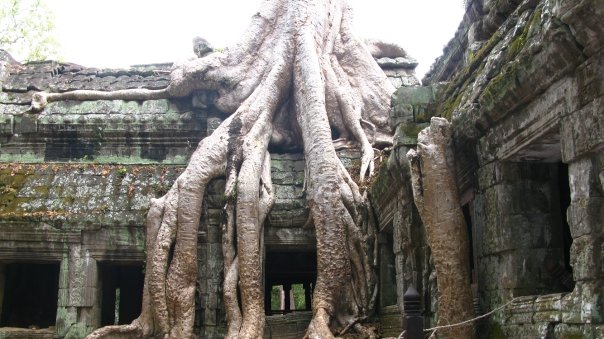
After two intense days of Temple’ing I was ever so happy to get back to my hotel and prepare myself for a rather rambunctious New Years Eve party. I met up with my two friends from Dubai at The Dead Fish Restaurant. The restaurant has an incredible ambiance. It is made up of what I like to call snakes and ladders. Patrons walk up ladders and sit on various platforms that seem to be floating in the air. Food is delivered to your floor by a pulley system from the kitchen. On the main floor, just in front of the bathroom there is a large pool which features about forty variously sized crocodiles. Somewhat of a restaurant hazard I’d say! Throughout our meal we were entertained by a traditional Aspara dance show. Local men and woman flicking their long fingers in the air would slowly sway to high pitched love songs which wafted through the air. After we all had stuffed our faces with Chinese dim sum, Thai curry and traditional Khmer dishes we headed back to our fave seat at Lingo Lounge.
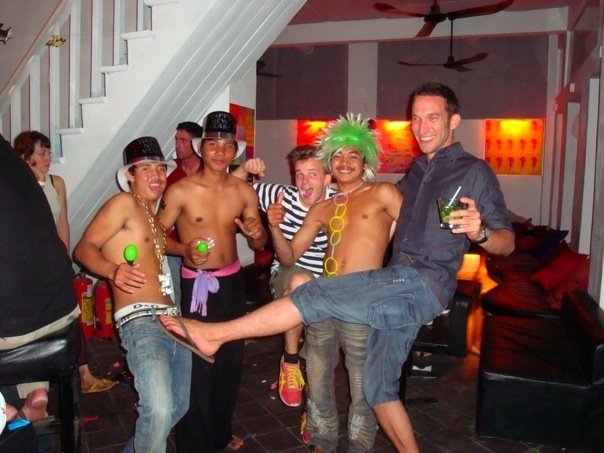
We sat overlooking the street with out martinis. All of a sudden the entire street went black. You could hear a collective drone. Cambodia is known for having really bad electrical systems. Apparently it isn’t that uncommon to have an entire city lose electricity for a few days. The owner of the bar came around to each of the tables with candles. The ambiance on the street was magical. I thought to myself, “I will never forget this New Years Eve where I sat on the street drinking a martini in the pitch black with a tiny candle at my feet.” Thirty minutes before midnight the electricity in town boomed back on. An intense flare of light and sudden pulse of music attacked our now calm and quiet senses.
We walked over to Bar Street just before the countdown and had a blast at the cities New Years Eve Dance Party. The street was full of thousands of tourists and locals dancing with beer and cocktails in hand. All of a sudden everyone was screaming 10, 9, 8…and moments later fire works shot into the sky and everyone jumped into the confetti filled air. For the next hour we danced to tunes by Fatboy Slim, Justice and Daft Punk. A wild way to welcome the New Year.
